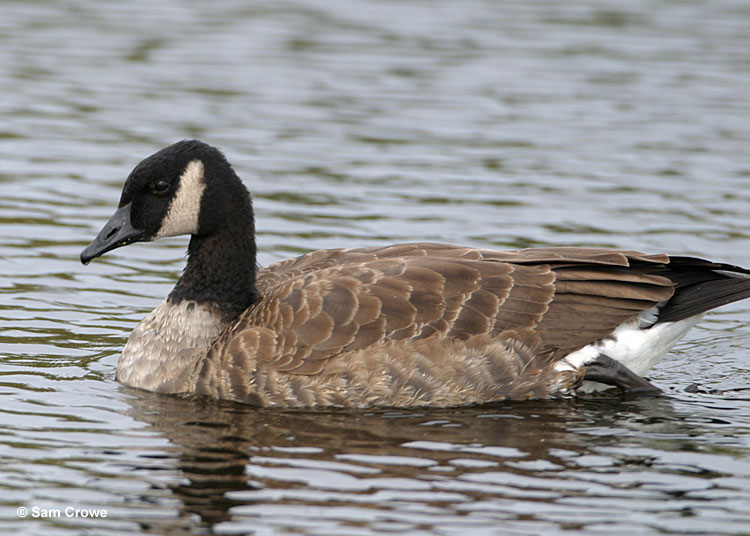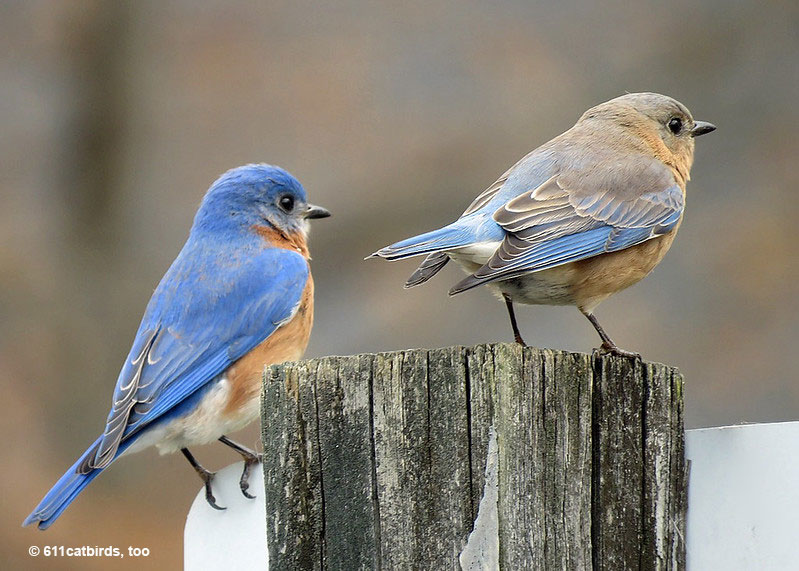
With a list of 439 bird species, “The Show Me State” could easily be called, “The Show Me the Birds State”!
The birds of Missouri thrive in 69,715 square miles of grasslands, forest, swamps, wetlands, and farmlands. Thanks to this state’s location, we can see several warblers in the east, prairie birds in the north, and Greater Roadrunners in the south!
Although grassland birds have declined and Passenger Pigeons are extinct, most birds in Missouri are common and easy to see.
Have you watched birds in Missouri? There’s a lot to identify but this up-to-date list of common backyard and wild birds in Missouri will help!
On this page
- Most common birds of Missouri
- Northern Cardinal
- Blue Jay
- Mourning Dove
- Red-bellied Woodpecker
- Downy Woodpecker
- Tufted Titmouse
- American Robin
- American Crow
- American Goldfinch
- European Starling
- House Finch
- White-breasted Nuthatch
- Carolina Wren
- House Sparrow
- Carolina Chickadee
- Dark-eyed Junco
- Canada Goose
- Turkey Vulture
- White-throated Sparrow
- Red-winged Blackbird
- Northern Flicker
- Eastern Bluebird
- Black-capped Chickadee
- Song Sparrow
- Common Grackle
- Indigo Bunting
- Red-tailed Hawk
- Great Blue Heron
- Brown-headed Cowbird
- Mallard
- Ruby-throated Hummingbird
- Killdeer
- Eastern Wood-Pewee
- Red-shouldered Hawk
- Barn Swallow
- Frequently Asked Questions
Most common birds of Missouri
To make the best, up-to-date list of the most commonly seen birds in Missouri, we used data from eBird to create a reliable list of birds.
We ordered them from the most common to the least common (remember that the birds at the bottom of the list are common too!).
To help learn about these birds, we included information about their field marks and behavior.
Northern Cardinal
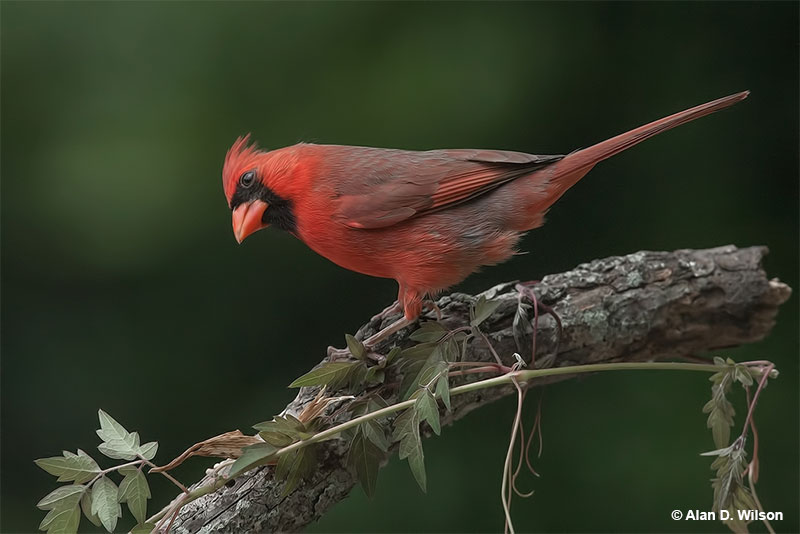
Scientific name: Cardinalis cardinalis
Length: 8.75 inches
Weight: 1.6 ounces
Wingspan: 12 inches
Song: “pichew-pichew-pichew, chew,chew,chew,chew,chew”
Northern Cardinals are medium-sized songbirds with a perky crest and big orange-red beak. Males are bright red with a black throat and face, and have dusky red on their back, wings, and tail.
Female Northern Cardinals are grayish-brown and buff with some black on their face and throat. They also have red highlights in their crest, wings, and long, rounded tail.
This species has short, rounded wings and seems to bounce up and down as they move through the air.
The Northern Cardinal is a bird of second growth, gardens, and parks. It eats seeds, insects, and some fruit and is a regular visitor to bird feeders.
This beautiful bird occurs in pairs and nests in bushes and low trees. It is common in the eastern and southwestern USA, southern Ontario, and in Mexico, and is one of the most common birds of Missouri.
Key Identifications:
- Crested bird with a conical orange-red beak and a black face. Males are red, females are grayish-brown and buff.
- Forages for seeds and insects on and near the ground.
- Makes a cup-shaped nest in bushes and low trees.
- Sings a clear, whistled song of repeated notes. They can sound like “cheer, cheer, chew, chew, chew, chew” or a quick “birdee,birdee,birdee,birdee,birdee“. They also make loud, sharp chip notes.
Northern Cardinals are one of the most beautiful common birds in most states, including Missouri. It’s no wonder seven different states chose it to be their official bird. Another fun fact about this species is that female Northern Cardinals also sing. They sing while sitting on the nest and may do so to tell their mates to bring food or warn them about predators.
Blue Jay
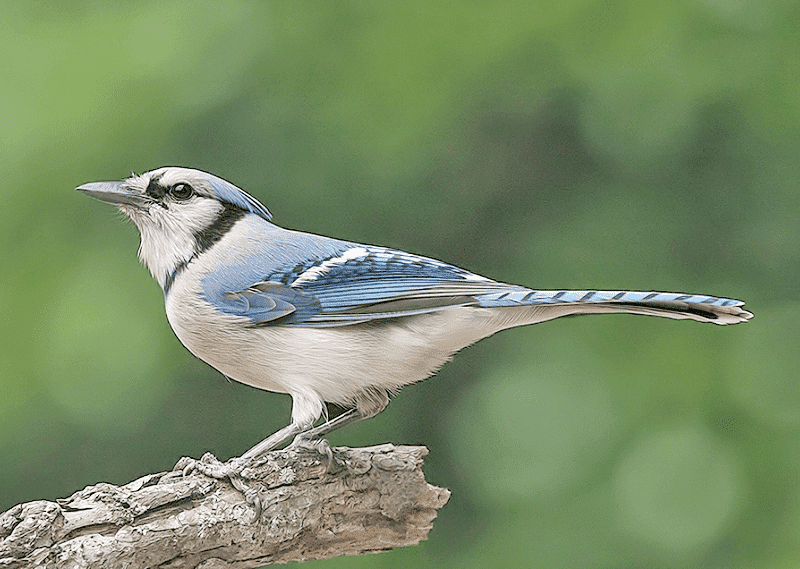
Photograph © Alan Wilson.
Scientific name: Cyanocitta cristata
Length: 11 inches
Weight: 3 ounces
Wingspan: 16 inches
Song: “Nyeah! Nyeah! Nyeah!”
The Blue Jay is a fairly large, crested bird with a straight black bill. Both sexes look alike and are blue above and gray and white below. They also have some small black lines on their faces and a narrow black necklace that goes up to the side of their face and crest.
Blue Jays also have some white markings and black barring in their wings and on their tail. Young birds look like adults but are duller blue.
They make messy cup nests at various heights in a variety of trees.
These social and intelligent birds feed on acorns, nuts, insects, and other small creatures. Like other members of the jay and crow family, they eat the eggs and nestlings of other birds.
The Blue Jay is a common bird of woodlands, forest, and towns east of the Rocky Mountains in the USA and central and southern Canada.
Key Identifications:
- Crested, fairly large bird with bright blue above and gray below.
- Feeds in trees and at feeders. Eats acorns, nuts, insects and many other food items.
- Makes a messy cup nest of sticks in a tree.
- Very vocal. In flight, Blue Jays often call as they swoop through the trees. They make a variety of sounds and mimic some other birds. Common calls include a nasal and complaining “Nyeah! Nyeah! Nyeah!” and various whistled calls.
The Blue Jay is a common, intelligent, and noisy bird. They make their presence known with their loud calls and can visit feeders. Ironically, when communicating with each other at close quarters, this species makes much softer and quieter calls. It’s almost as if they are talking with each other!
Mourning Dove
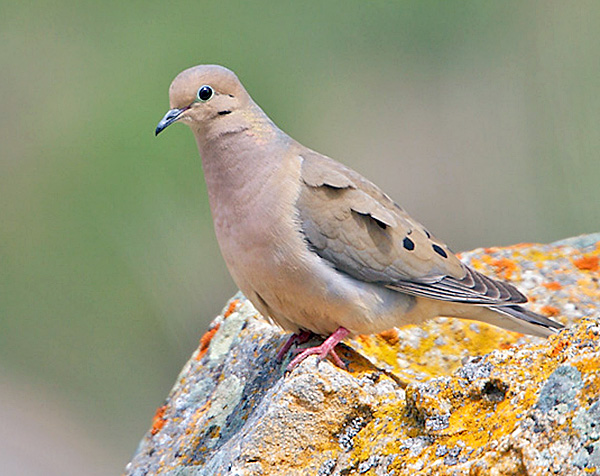
Photograph © Greg Lavaty.
Scientific name: Zenaida macroura
Length: 12 inches
Weight: 4.2 ounces
Wingspan: 18 inches
Song: “hooOOA, hoo, hoo, hoo”
Mourning Doves are medium-sized, grayish-brown doves with long tails. They have small black spots on their wings and a small head with a slender, dark beak.
Males and females also have narrow gray eyerings, a black mark on the face, and pale iridescent gold on the sides of their necks. They look alike except for males having more gray on the head and neck, and more iridescence.
This dove has fairly long wings and swift, direct flight. During the flight, it shows black and white in its tail.
Mourning Doves live in woodlands, gardens, on farms, and in urban areas. This common feeder visitor eats seeds and grains. It also forages in open situations, picking food from the ground.
This pleasant dove species can visit a feeder on its own or forage in small flocks. It builds an unkempt stick nest in bushes and trees and is very common throughout the USA (including Missouri), southern Canada, and Mexico.
Key Identifications:
- Plain brown and gray dove with a long, pointed tail.
- Feeds on seeds at feeders and on the ground in open areas.
- Makes a small, messy nest of sticks in trees.
- Sings a sad and owl-like “hooOOA, hoo, hoo, hoo”.
The Mourning Dove is the common garden dove in most of its range. Mourning Doves often visit feeders, and their cooing song is can be mistaken for an owl. This species has a short lifespan with many adults only living for a couple of years or less.
Red-bellied Woodpecker
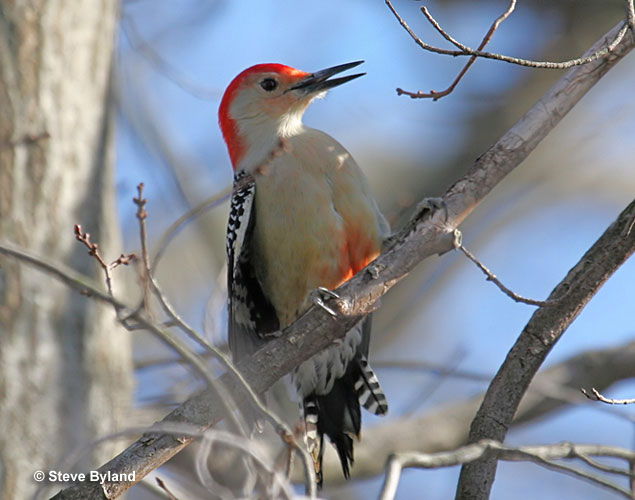
Scientific name: Melanerpes carolinus
Length: 9.25 inches
Weight: 2.2 ounces
Wingspan: 16 inches
Song: “Qwerr!”
Red-bellied Woodpeckers are medium-sized with black and white barring on their back and wings. They have a long beak and pale gray underparts with a small red patch on the belly.
Males have red on the head from the bill to the back of the neck (the nape). Females have an orange-red spot above their bill and red on the back of their head. Both sexes have a mostly white rump and central tail feathers.
This woodpecker species has long wings and “undulating” flight, where it moves up and down as it flies. In flight, Red-bellied Woodpeckers show a small white patch in their wings.
The Red-bellied Woodpecker lives in wooded habitats. It eats nuts, seeds, insects, fruit, and can attack nestlings of other species. It also visits bird feeders.
This striking woodpecker occurs in pairs and nests in tree cavities high above the ground. It is common in the eastern USA and parts of southern Ontario.
Key Identifications:
- Grayish woodpecker with black and white barring above, and red on the top of the head and back of the neck.
- Forages for seeds, nuts, insects and other food on trunks and branches.
- Nests in a tree cavity, high overhead.
- Makes a loud exclamation, “Qwerr!“. It also makes other, briefer and quieter “chug” calls.
Red-bellied Woodpeckers are common and adaptable birds. As long as big trees are present, we see them in urban areas as well as wilder places. They also visit feeders and have a very long tongues. When extended, it sticks out 2 inches past the tip of its bill!
Downy Woodpecker
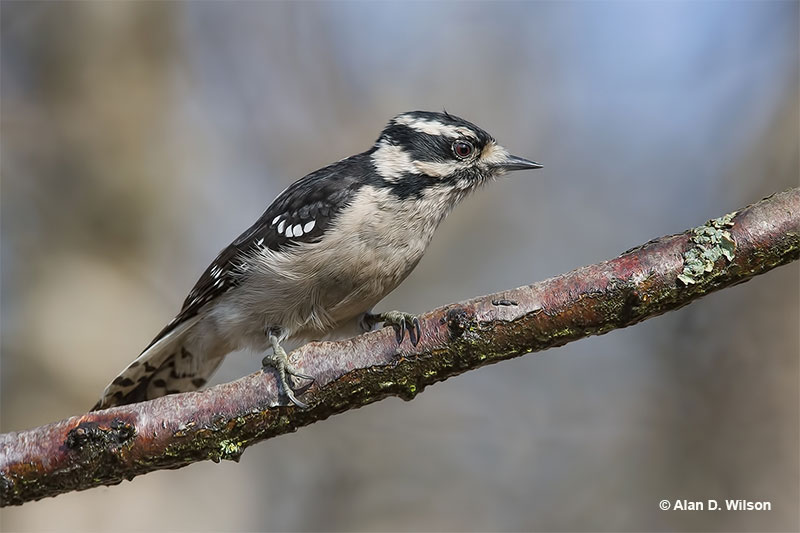
Scientific name: Dryobates pubescens
Length: 6.75 inches
Weight: .95 ounces
Wingspan: 12 inches
Song: “Pik! Ch,ch,ch,ch,ch,ch,ch!”
The Downy Woodpecker is a small black and white woodpecker with a short, black beak. They are patterned black and white above and have white backs and white underparts. Both sexes look alike, except that males have a small, bright red patch on the top back part of their head.
Young birds look like adults but have a reddish patch on the top of their heads. Downy Woodpeckers also have a few small black marks in their white outer tail feathers, and a small white tuft at the base of their beak.
This woodpecker eats insects, other small creatures, seeds, and small fruits. It pecks into live and dead wood and often forages on smaller branches and twigs. These friendly little woodpeckers are also common feeder birds.
They nest in tree cavities and live in gardens and a wide variety of woodlands. We see Downy Woodpeckers in much of Canada and the USA but not in arid habitats.
Key Identifications:
- The smallest woodpecker in North America. Mostly black and white with a short, black beak.
- Forages on trees, in bushes, and at feeders for insects, seeds, and suet.
- Nests in tree cavities.
- The Downy Woodpecker makes sharp “pik!” calls and also has a trilled call, “Ch,ch,ch,ch,ch,ch,ch!“.
Downy Woodpeckers are the smallest woodpecker species in North America and usually occur in pairs. They can also forage with other small birds and often visit feeders. This species takes advantage of its size to peck into the stems of weeds and other plants too small for larger woodpeckers to perch on.
See more: Woodpeckers in Missouri
Tufted Titmouse
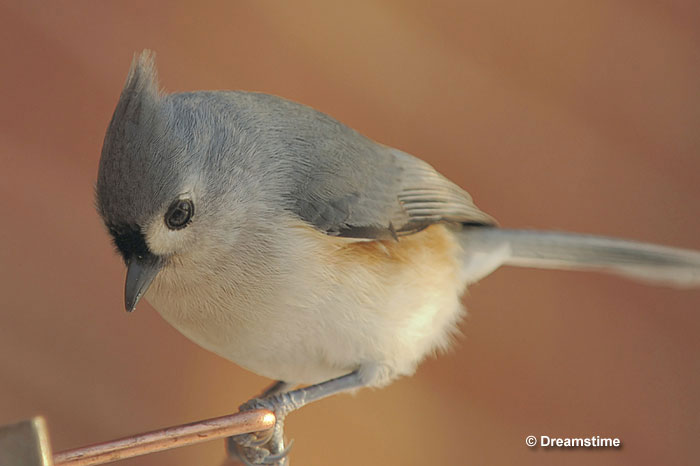
Scientific name: Baeolophus bicolor
Length: 6.5 inches
Weight: .75 ounces
Wingspan: 9.75 inches
Song: “peter peter peter”
The Tufted Titmouse is a small, crested, blue-gray bird with a white face. Males and females look the same and have a small black mark above their stubby black beak. They also have pale underparts with peach-orange flanks.
These cute little birds occur in small groups that forage for insects and seeds in parks and woodlands. They move through the trees and use their bills to pick food from leaves, bark, and branches. Tufted Titmouse are also regular visitors to bird feeders.
These small birds nest in woodpecker holes and other cavities in dead trees, and can also use nest boxes.
We find the Tufted Titmouse in hardwood forests and forested urban areas. They are often heard before they are seen, and flock with other small birds. When they see a predator, they are some of the first birds to harass it.
The Tufted Titmouse occurs in the eastern USA and some parts of southeastern Canada, and is one of the most common birds of Missouri.
Key Identifications:
- Small, crested blue-gray bird with pale underparts and a white face.
- Feeds on seeds and insects and visits feeders.
- Nests in tree cavities and nest boxes.
- The Tufted Titmouse is a very vocal bird. It gives constant whistled calls over and over, “peter peter peter“.
The Tufted Titmouse is an easily recognized bird that lives in parks, gardens, and woodlands. It occurs in small flocks, often visits feeders, and needs dead trees or nest boxes to breed. This species lines its nest with mammal hair including fur from Raccoons, Opossums, and other animals.
American Robin

Photograph © Tom Grey
Scientific name: Turdus migratorius
Length: 10 inches
Weight: 2.7 ounces
Wingspan: 17 inches
Song: “cheery, cheery, cheery, cheery, cheer, cheer”
The American Robin is a familiar and common thrush that is dark gray above and brick red below. It also has an orange-yellow bill, a blackish head with white markings around the eyes and on the throat, and a white belly.
Both sexes of this thrush species are similar but males are darker above and more reddish on the underparts. Young American Robins have more white marks on their faces and spotting on orange underparts.
In flight, this common thrush in Missouri also shows white corners in its outer tail feathers.
The American Robin makes a cup nest in trees and lives in parks, woodlands, towns, and many other habitats. They reside in Alaska, most of Canada, the USA and in Mexico.
Key Identifications:
- Fair-sized songbird that is dark gray above, and brick red and white below.
- Forages for worms and bugs on lawns and other open grassy areas, also flocks together to feed on fruiting trees in the winter.
- Makes a cup nest in trees.
- The American Robin is quite vocal and makes a loud, sharp, “yenk!” call and quieter “check,check,check” calls. It also has a lovely cheerful song of caroled phrases, “cheery, cheery, cheery, cheery, cheer, cheer”.
The American Robin is a common, handsome thrush with dark gray upperparts and brick red and white underparts. It forages for worms and bugs on lawns and other open, grassy spots, and also eats berries. Populations of the American Robin have been estimated at 370,000,000; a number that gives this bird the distinction of being the most numerous landbird in North America.
American Crow
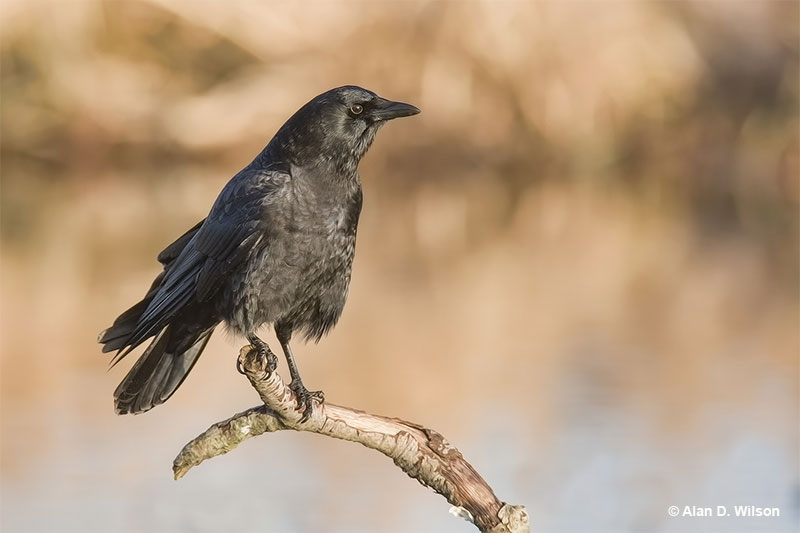
Scientific name: Corvus brachyrhynchos
Length: 17.5 inches
Weight: 1 pound
Wingspan: 39 inches
Song: “Caw! Caw!”
The American Crow is a big, all-black bird with a strong, stout bill. In certain lighting, it can have metallic purple and blue iridescence.
Both sexes look the same and have some feathering on their beaks, long, broad wings, and a broad tail.
American Crows have a direct flying style, with strong, steady wing beats. Crows are very social and intelligent birds that are usually seen in flocks. They forage together on the ground or in trees and eat just about anything they can find.
Some of their more regular foods include carrion, fruit, nuts, seeds, insects, and small animals. Like most jays and crow species, they also eat the eggs and nestlings of other bird species.
This species builds bulky stick nests high in trees and lives in most habitats except for high mountains and arid zones.
The American Crow occurs in southern Alaska and much of Canada and the USA, and is one of the most common birds of Missouri.
Key Identifications:
- Big, all black bird with long, broad wing and a broad tail.
- Forages for carrion, fruit, seeds, insects, and small animals.
- Builds a bulky stick nest high in a tree.
- American Crows are very vocal birds. They can make several calls but their most common one is, “Caw! Caw! Caw!”.
The American Crow is a common, large black bird that frequently calls, “Caw! Caw! Caw!”. It usually occurs in flocks and lives in all sorts of places, even urban zones. These birds are very smart and have funerals or wakes! When a crow dies, other crows mark the occasion by gathering together and loudly calling.
American Goldfinch
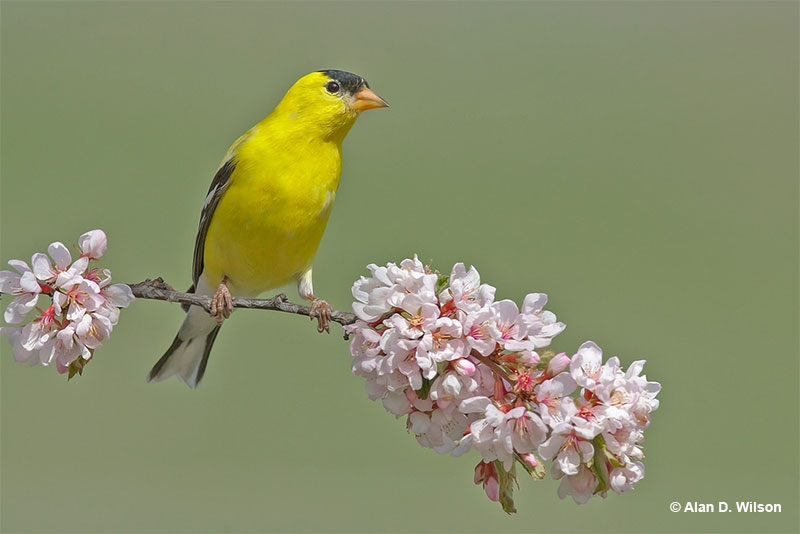
Scientific name: Spinus tristis
Length: 4.3 to 5.1 inches
Weight: 0.4 to 0.7 ounces
Wingspan: 7.5 to 8.7 inches
Song: “po-ta-to-chip”
Adult male American Goldfinches have black foreheads, black wings with white markings, white patches both above and below the tail, and are bright yellow overall in the spring and early summer. Female American Goldfinches are paler yellow underneath and olive above. In the winter, both males and females are unstreaked brown, drab, and have blackish wings with two faint wing bars.
American Goldfinches inhabit overgrown areas like open floodplains and weedy fields, especially thistle, aster, and sunflower plants. They feed off of these plants and use trees and shrubs for nesting. It’s not uncommon to see these birds in backyards, parks, and suburbs as well.
American Goldfinches primarily consume seeds; it’s rare to see them consume anything else. The main types of seeds they eat include thistle, sunflower, grass seeds, and asters.
Key Identifications:
- Male birds have black foreheads, black wings with white markings, white patches both above and below the tail, and are bright yellow overall in the spring and early summer.
- Male and Female American Goldfinch look similar. Females are paler yellow underneath and olive above. Both males and females look the same in the winter.
- These birds are smaller than Tufted Titmice.
- The Eastern Goldfinch is a small species of finch. They have short, notched tails, short, conical bills, long wings, and a small head.
American Goldfinches are very acrobatic and active birds. You can commonly see them balancing on thistle seedheads, dandelions, and other plants to pick seeds. Goldfinches are known to visit bird feeders as long as you offer the right seeds. To encourage these finches to visit your yard, it’s highly recommended that you plant native composite plants like thistles and milkweed.
European Starling
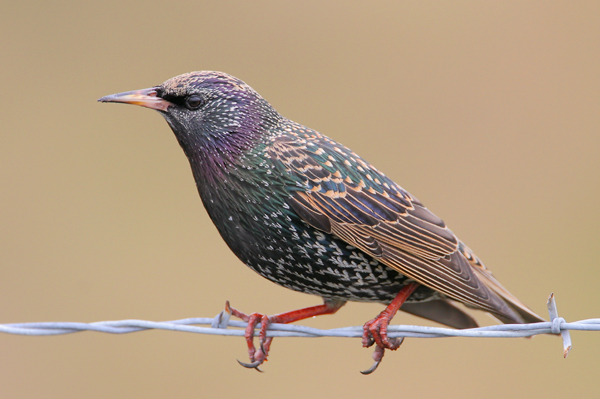
Photograph © Greg Lavaty.
Scientific name: Sturnus vulgaris
Length: 8.5 inches
Weight: 2.9 ounces
Wingspan: 16 inches
Song: “tiktiktitZHREEree..tiktiktik..ZHREE”
European Starlings are plump, short-tailed birds with long sharp beaks and longish, pointed wings. In summer, they have yellow beaks, glossy black plumage with purple and green highlights, and some small white spots.
Males and females are similar but males have less spotting and glossier plumage. In winter, they have black beaks, white spots, and more reddish colors in their wings.
Young starlings are shaped like adults but are grayish birds with a dark beak and a pale throat.
This species feeds on a variety of insects, fruit, and seeds. They can dominate bird feeders and are common species in urban areas, parks, farmlands, and other open habitats.
This European Starling builds a soft cup nest in a tree cavity, nest box, or suitable cavity in other structures.
European Starlings flock with each other and blackbird species, especially during the winter. They live across a large part of Canada and the USA, making them one of the most common birds of Missouri.
Key Identifications:
- Rotund, short-tailed bird with a long, sharp beak, and pointed wings. Glossy black with some spotting in the summer and blackish with heavy white spotting and streaking in the winter.
- Feeds on seeds, fruit, and insects. Visits feeders and forages on the ground in flocks.
- Builds a soft cup nest in nest boxes and other cavities.
- The European Starling makes a wide variety of mechanical and whistled sounds. They also mimic other birds and sounds in their environment. They sing long, jumbled mechanical-sounding songs, “tiktiktitZHREEree..tiktiktik..ZHREE”.
European Starlings are rounded, blackish birds with long, sharp beaks and short tails. This species forms large flocks called, “murmurations” that move in coordinated patterns.
House Finch
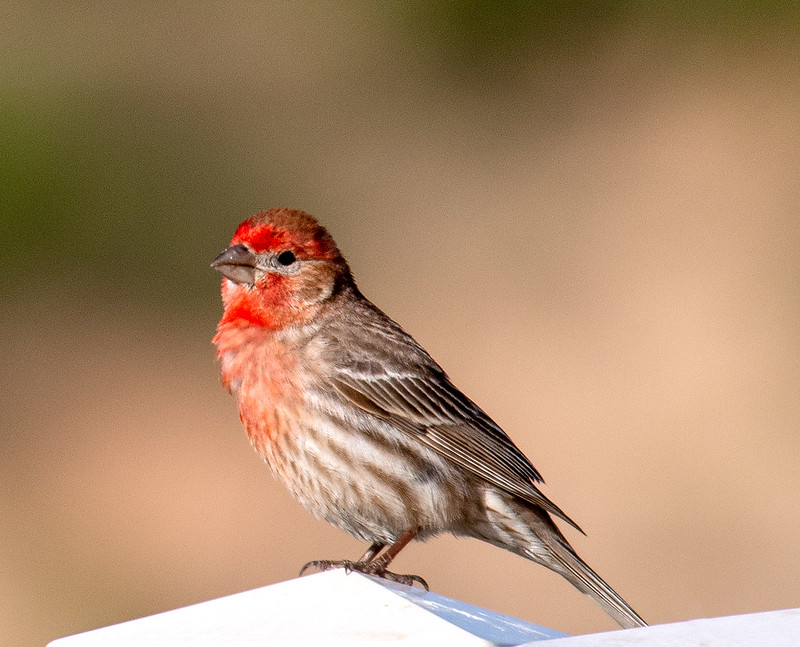
Photograph © John Hansen
Scientific name: Haemorhous mexicanus
Length: 6 inches
Weight: .88 ounces
Wingspan: 10 inches
Song: “chip,chip,chiprididip,ZREEYachip”
House Finches are sparrow-sized birds with dark, rounded beaks and fairly long wings. Males are orange-red or rose-red on their head, throat and breast, and have some red on their rump. They also have brownish streaks on their back, flanks, and white belly.
Like the male, female House Finches have two white wing bars on long, gray-brown wings. However, they lack red and are mostly streaked, dull brown-gray birds.
House Finches feed on seeds, buds, fruit, and flowers. They often visit feeders in Missouri but also forage on the ground, and in bushes and trees.
We see these pretty birds in deserts and arid zones, and in parks, farmland, urban areas, and other semi-open habitats.
The House Finch makes a soft cup nest built on a tree, building ledge or other spot with some overhanging cover. They often occur in small groups and live in southern Canada, most of the USA, Mexico, and Hawaii.
Key Identifications:
- Reddish or plain gray-brown, streaked, sparrow-like bird.
- Eats seeds, flowers, buds, and fruit. Can visit feeders but also forages on the ground and in bushes and trees.
- Makes a soft cup nest in trees, on building ledges, and other places.
- The House Finch often makes a soft, “fidip” call. Males also sing a warbling song from prominent, high perches. It sounds like, “chip,chip,chiprididip,ZREEYachip”.
House Finches are sparrow-like, reddish or brownish, streaked birds. They live in arid zones as well as in parks and urban areas. All of the millions of House Finches that live east of the Rocky Mountains are descendants of birds released on Long Island in 1939.
White-breasted Nuthatch
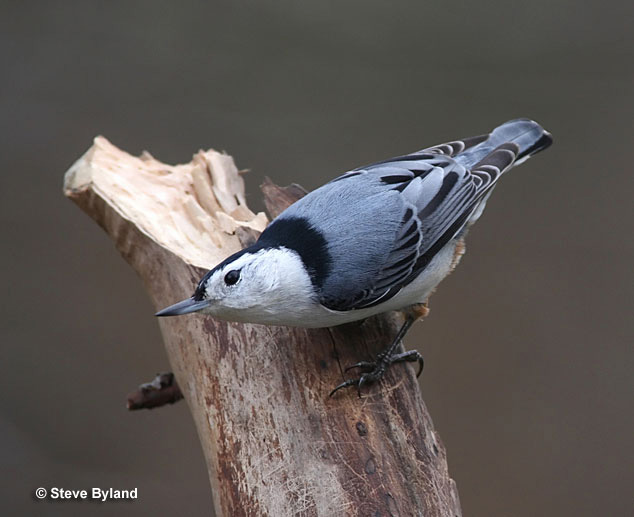
Scientific name: Sitta carolinensis
Length: 5.1 to 5.5 inches
Weight: 0.6 to 1.1 ounces
Wingspan: 7.9 to 10.6 inches
Song: “wha-wha-wha”
White-breasted Nuthatches have frosty white underparts and faces as well as gray-blue backs. Additionally, under the tail and the lower belly are chestnut brown, and the cap and neck are either black or gray.
White-breasted Nuthatches inhabit mature woods and are most commonly found in coniferous and deciduous forests. You can also find them in open areas with large trees and at woodland edges.
Nuthatches primarily consume insects. Some of the prey they consume include tree hoppers, beetles, weevil larvae, ants, wood-boring beetle larvae, and caterpillars. They also eat nuts and seeds like sunflower seeds and acorns.
Key Identifications:
- White-breasted Nuthatches are smaller than a Tufted Titmouse.
- White-breasted Nuthatches have frosty white underparts and faces and gray-blue backs.
- These birds have large heads, almost no necks, narrow, straight bills, and very short tails.
- White-breasted Nuthatches can be easily identified by their habit of sneaking up and down tree trunks.
White-breasted Nuthatches are widespread, agile little birds. They visit bird feeders and will readily consume mealworms and meaty, large seeds. White-breasted Nuthatches are known as the “upside down” bird. This is because it’s not uncommon to see them creeping headfirst down the trunk of a tree in search of insects.
Carolina Wren
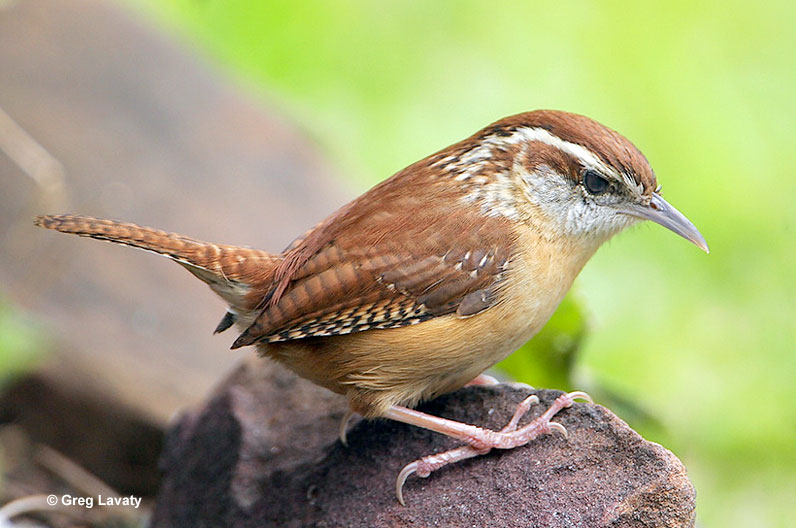
Scientific name: Thryothorus ludovicianus
Length: 5.5 inches
Weight: .74 ounces
Wingspan: 7.5 inches
Song: “teakettle, teakettle, teakettle”
The Carolina Wren is a small, reddish-brown and buff bird with a long, sharp, slightly decurved beak. It has a long, narrow, white eyebrow, a white throat, and some white mottling on its face. Males and females are similar and have black barring on their short wings, long tail, and under the tail.
Juveniles are similar but have paler underparts. This animated and vocal little bird forages for bugs in vine tangles and other dense vegetation. It usually occurs in pairs that can easily hide in the dense vegetation they prefer.
Carolina Wrens build a domed, cup nest made of sticks and soft vegetation. There is a side entrance and it can be placed in cavities and crevices of stumps, bushes, trees, potted plants, and other structures.
The Carolina Wren lives in vegetated gardens, second growth, parks and similar habitats in much of the eastern USA, parts of southern Ontario, and parts of eastern Mexico.
Key Identifications:
- Small reddish-brown and buff bird with a long beak and long white eyebrow.
- Feeds on arthropods in dense, tangled vegetation.
- Makes a domed cup nest with a side entrance in crevices, tree cavities, and human-made structures.
- Carolina Wrens fill the garden with loud and melodious songs. One common song sounds like, “teakettle, teakettle, teakettle“. They also make trilled sounds and harsh, nasal calls.
The Carolina Wren is a vocal species of gardens and second growth. Pairs use their long beaks to catch bugs and insects and aren’t shy about nesting near people. Many of these friendly birds have nested in such places as old shoes, potted plants, and abandoned cars.
House Sparrow
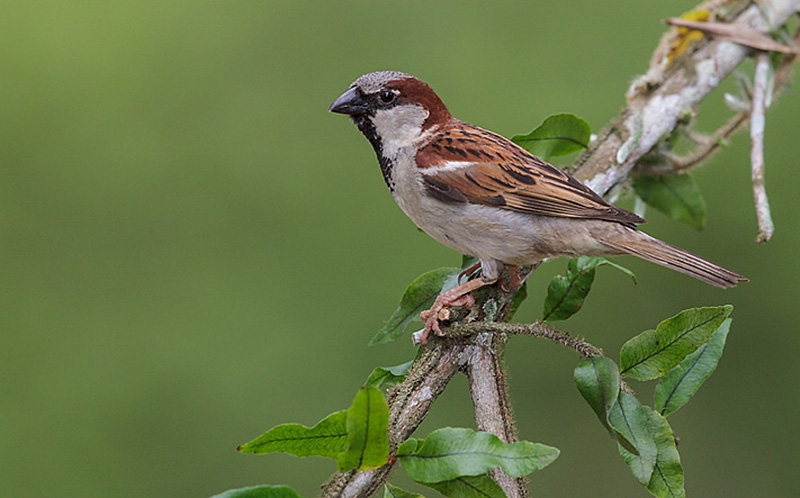
House Sparrow (Passer domesticus) perched on a branch in the Atlantic rainforest of southeast Brazil.
Scientific name: Passer domesticus
Length: 6.25 inches
Weight: .98 ounces
Wingspan: 9.5 inches
Song: “see,chirrup,see,chirrup,see,chirrup”
House Sparrows are small, plump gray and brown birds with conical, finch-like beaks. Males have a gray and rufous head with pale cheeks, and black near their eyes and on their throat.
The rest of their underparts are gray and they have brown, streaked backs with rufous highlights. They also have a white mark in the shoulder of each wing and a grayish rump and tail.
Females are plainer brown and buff, have paler beaks, and buff eyebrows.
House Sparrows feed on seeds, grain, and insects. They are regular visitors to bird feeders and often dominate other smaller species. They also forage on the ground in farmlands, parks, urban areas, and other open situations.
The House Sparrow nests in cavities. When searching for suitable nesting sites, they can kill and remove the eggs and young of smaller species like Eastern Bluebirds.
House Sparrows usually live near people and occur in most of North America, including Missouri.
Key Identifications:
- Brown and gray sparrow with a bold pattern on its head.
- Feeds on seeds, grain, and insects at feeders and on the ground in urban areas and farmlands.
- Nests in tree cavities, including nest boxes.
- This species is vocal and often makes short chirping calls. Its song is a friendly series of chirping sounds, “see,chirrup,see,chirrup,see,chirrup”.
In many places, the House Sparrow is the common urban sparrow. It occurs in pairs and small groups that forage on sidewalks, in parking lots, farm fields, and other familiar places. This species is one of the very few birds that has evolved to live with people and digest the same grains that we eat.
Carolina Chickadee
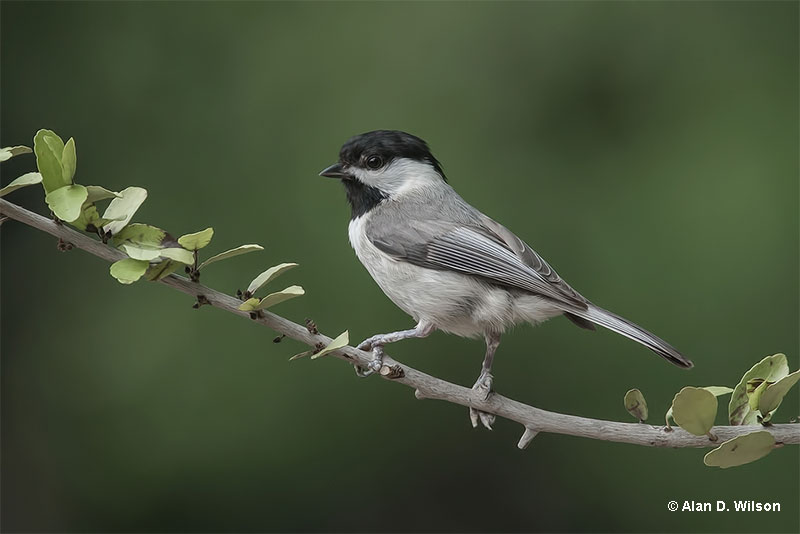
© Alan D. Wilson
Scientific name: Poecile carolinensis
Length: 4.75 inches
Weight: .37 ounces
Wingspan: 7.5 inches
Song: “see-dee, see-dew”
The Carolina Chickadee is a small, cute, grayish and buff bird with a black cap, black throat, and white face. Males and females look the same and have stubby black beaks, strong, blue-gray legs and feet, and some pale edging on the feathers in their wings and tails.
This small bird mostly feeds on insects and seeds. It finds food by foraging with flocks of other small birds and picking small bugs and other items from bark, foliage, and twigs. Carolina Chickadees often hang upside down from twigs while foraging and are regular visitors to bird feeders.
These fun little birds nest in tree cavities and nest boxes, and live in parks, woodlands, and other habitats. As long as enough trees are present, they also commonly live in urban areas.
The Carolina Chickadee is a permanent resident from Maryland and Ohio west to Texas and south to northern Florida.
Key Identifications:
- The Carolina Chickadee is a small gray and buff bird with a smart black cap, black throat, and white face.
- Feeds on small insects and seeds. A regular visitor to bird feeders.
- Nests in tree cavities and nest boxes.
- Carolina Chickadees are vocal birds that make nasal “chick a dee dee dee” calls, and a high-pitched, “see-dee, see-dew”.
The Carolina Chickadee is a small grayish bird with a black cap and throat. They usually occur in small flocks that forage for insects and seeds as they chatter and move through woodlands and park-like habitats. This species uses its excellent memory to recall where it keeps hidden bits of food.
Dark-eyed Junco
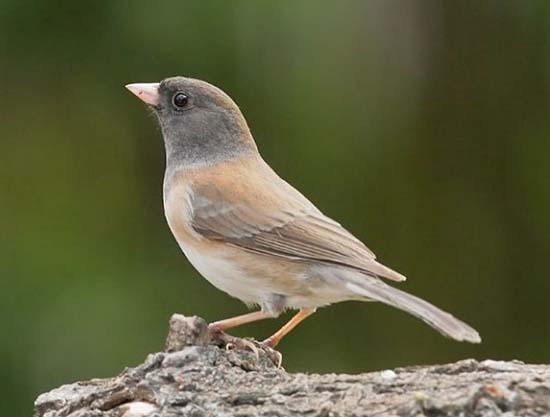
Scientific name: Junco hyemalis
Length: 6.25 inches
Weight: .67 ounces
Wingspan: 9.25 inches
Song: “sipsipsipsipsipsipsip”
Dark-eyed Juncos are sparrow-like birds with pale conical bills and dark eyes. This small bird has variable plumage with most being slate gray or gray and brown with white on their bellies, and white under their tails.
Other plumages include birds with dark masks and faint white wing bars, juncos with pale gray hoods and pinkish sides, and birds with blackish hoods and chestnut sides.
In flight, all Dark-eyed Juncos show extensive white in their longish tails.
This species feeds on seeds, insects, and some fruit and grain. Juncos forage on the ground in wooded areas, parks, and other habitats. They also feed on fallen seed beneath feeders.
They build cup nests on the ground under fallen logs, in roots, and other hidden spots. After breeding, juncos form flocks that forage together in similar wooded and semi-open habitats.
Dark-eyed Juncos are common birds in Canada, the USA, and parts of Mexico.
Key Identifications:
- Sparrow-like gray and brown bird with dark eyes, a pale beak, and white in the tail.
- Forages for seeds and insects on the ground, can feed on seeds at and beneath feeders.
- Builds a cup-shaped nest on the ground in tree roots, under logs, and other hidden places.
- This species often makes a sharp, high-pitched chip note, “pik!”. On breeding grounds, males sing a short, plain trill, “sipsipsipsipsipsipsip”.
Dark-eyed Juncos are sparrow-like, gray and brown birds with much white in the tail. Common wintering birds in many areas, they forage for seeds on the ground in wooded and park-like habitats. In many places, this common species is also known the “Snowbird” on account of only occurring in the winter months and having white on the belly and tail.
Canada Goose
Scientific name: Branta canadensis
Length: 29.9 to 43.3 inches
Weight: 105.8 to 317.5 ounces
Wingspan: 50 to 66.9 inches
Song: Canada Geese don’t have a song, but they do produce a variety of calls, including loud honks, hisses, cackles, and barks.
Canada Geese have white cheeks, black heads, white chinstraps, black necks, brown backs, and tan breasts.
Canada Geese live in many different habitats near grain fields, grassy fields, and water. These waterbirds are particularly drawn to lawns because when they’re caring for their young, manicured lawns give them an unobstructed, broad view of any approaching predators, and they can digest grass.
In the spring and summer months, geese concentrate on consuming sedges and grasses, including eelgrass and skunk cabbage leaves. During the fall and winter months, they rely more on seeds and berries, including berries and agricultural grains.
Key Identifications:
- Look for their white cheeks, white chinstraps, black heads, black necks, brown backs, and tan breasts.
- Male and Female Canadian Geese look identical. The best ways to differentiate the two is by looking at size and behavior.
- Canada Geese are larger than a Mallard.
- Canada Geese are large waterbirds. They have long necks, large bodies, wide, flat bills, and big webbed feet.
Thousands of Canada Geese migrate south and north every year. They’re easily recognizable with their long V-shaped formations. However, more and more of these birds are staying put in suburban and urban areas year-round, due to lawn maintenance.
Turkey Vulture
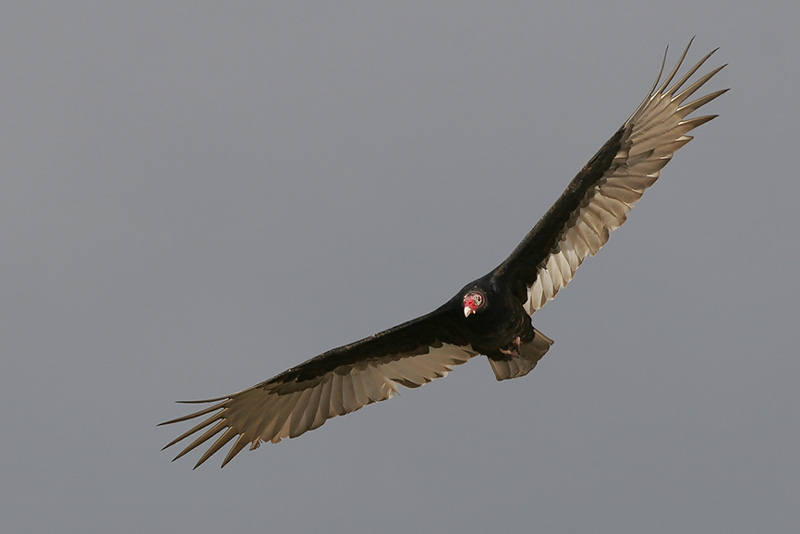
Scientific name: Cathartes aura
Length: 26 inches
Weight: 4 pounds
Wingspan: 67 inches
Song: “hisss”
The Turkey Vulture is a big, dark brownish-black raptor with a small red head and long, broad wings. Males and females look alike and also have a longish tail.
In flight, the way Turkey Vultures soar is one of the best ways to recognize them. They fly with their wings held in a “V” shape and, when gliding, often rock back and forth.
Their flight feathers are also paler than the rest of their wings but they lack the Black Vulture’s white wing patch.
Turkey Vultures are scavengers and most of their diet is carrion. They eat road kill and a wide variety of dead animals. This species forages over every type of habitat and can also fly over urban areas.
It lays two eggs on the ground in caves and hollow logs.
The Turkey Vulture lives in southern Canada and in most of the USA south to southern Argentina.
Key Identifications:
- Big, dark raptor with a small red head that soars with long wings held in a “V”.
- Feeds on dead animals.
- Nests on the ground in caves and hollow logs in secluded areas.
- Turkey Vultures rarely call and mostly make hissing sounds at their nest.
The Turkey Vulture is commonly seen flying over every type of habitat. They are often seen on their own but can occur in flocks, especially during migration. Unlike most other birds, this species uses its amazing sense of smell to find dead animals.
White-throated Sparrow
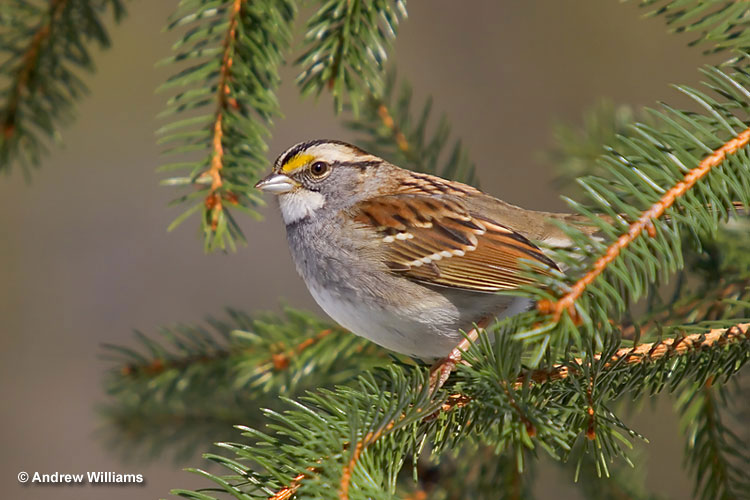
Scientific name: Zonotrichia albicollis
Length: 6.75 inches
Weight: .91 ounces
Wingspan: 9 inches
Song: “Ohhh Canada Canada Canada”
The White-throated Sparrow is a chunky, gray and brown sparrow with a white throat, and black and white stripes on its head. It has dark streaks on its back, a gray rump, and a bit of yellow in front of its eyes.
Males and females look the same and have reddish-brown wings with two white wing bars. Young White-throated Sparrows and some adults are duller brown with tan stripes on their heads and a dingy white throat.
White-throated Sparrows forage for seeds and insects on the ground, and also eat fruits in short trees and bushes. They reveal hidden food items by using their feet to scratch and kick away leaves.
This sparrow breeds in northern forests and builds a cup nest with grass and twigs. They construct the nest at the edge of forest, on or close to the ground, in dense vegetation.
These sparrows usually occur in flocks and winter in the eastern and southwestern USA and parts of California.
Key Identifications:
- Large sparrow with a white throat and bold black and white or tan stripes on its head.
- Scratches leaves on the ground to find seeds and insects. They also eat berries.
- Makes a cup nest of grass, bark, and twigs, on the ground, under dense vegetation.
- Flocks of White-throated Sparrows often make sharp “tink” calls. They also sing a clear, whistled song, “Ohhh Canada Canada Canada” or, “Ohhh, Cana, Cana, Cana”.
The yellow pigment in the patches in front of their eyes comes from eating colorful berries during fall and winter.
Red-winged Blackbird
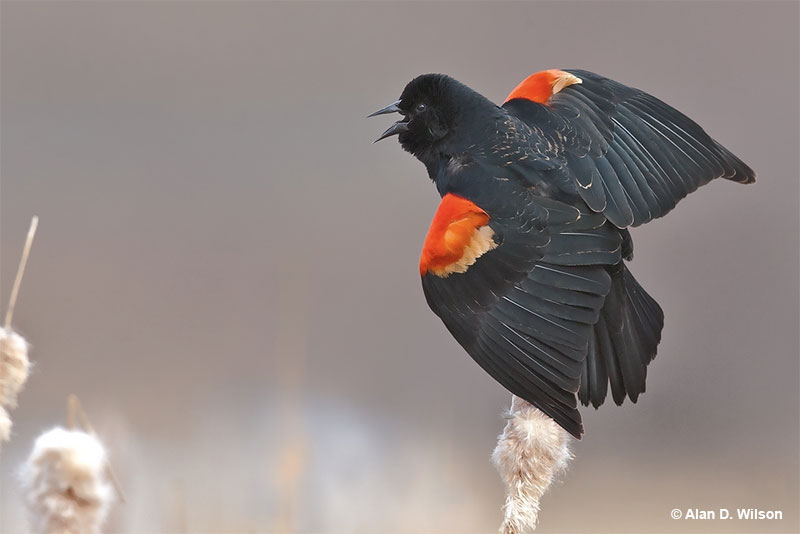
Scientific name: Agelaius phoeniceus
Length: 8.75 inches
Weight: 1.8 ounces
Wingspan: 13 inches
Song: “kan-keree!”
The Red-winged Blackbird is a medium-sized blackbird species with a sharp, all black bill. Males also have a scarlet patch with a pale yellow border on the shoulder of each wing.
Female Red-winged Blackbirds are dark, heavily streaked, brownish-gray birds with an orange-buff eyebrow and throat. She can also have a little bit of dingy red on her shoulder.
Red-winged Blackbirds often flock together and can form very large groups in the winter. They feed on seeds, grain, and insects found on lawns, in marshes, farm fields, and other open habitats.
This species builds a cup nest made of leaves and dead stems in a bush or other low vegetation in a marsh, park, or brushy field.
Red-winged Blackbirds are very common birds that live in all sorts of open habitats. We see them in parks, farming areas, and marshes in much of Canada, the USA, Mexico, and parts of the Central America.
Key Identifications:
- Males are medium-sized blackbirds with a bright red patch on their wings. Females are heavily streaked, have a sharp black beak, and buff on the head.
- Feeds on seeds, grain, and insects on the ground in many open habitats.
- Builds a cup nest in a bush or other low vegetation.
- Red-winged Blackbirds often call. Males sing a loud, “kan-keree!” and both sexes also make “check!” calls and a high-pitched whistle-like sound.
The Red-winged Blackbird is a common, social species easily seen in marshes and open habitats. In the winter, it can form huge flocks that feed in farm fields. This species can make a daily commute of 50 miles to and from roosting and feeding sites.
Northern Flicker
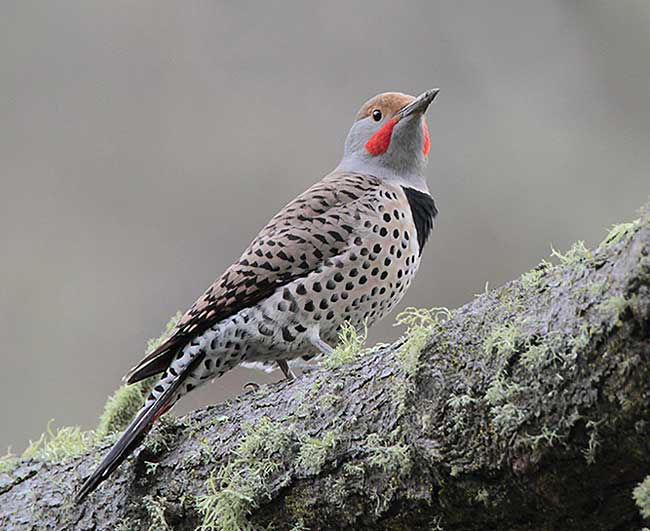
Scientific name: Colaptes auratus
Length: 12.5 inches
Weight: 4.6 ounces
Wingspan: 20 inches
Song: “kick,kick,kik,kik,kik.kik.kik.kik.kik.kik.kik.kik!”
Northern Flickers are fairly large, tan and gray woodpeckers with barring on their backs. They have a black mark on their breast, black spotting below, and a dark, stout beak.
Males in the east have a tawny throat and face with a black moustache and small red spot on the back of their heads. Males in the west have mostly gray heads with a red moustache.
Female Northern Flickers look like males but lack the moustache mark.
In bounding flight, they have white rumps and flash color on their underwings. This is bright yellow in eastern birds and reddish in flickers west of the Rocky Mountains.
This woodpecker eats many ants and other insects that it catches on the ground. It forages by flying to the ground, locating anthills, and lapping them up with its long tongue.
Northern Flickers nest in tree cavities and live in wooded and open habitats in Canada, the USA, and Mexico. Northern Flickers are known as one of the most common birds of Missouri.
Key Identifications:
- Tan and gray woodpecker with black barring above, black marks below, and a bright, white rump.
- Forages for ants and other insects on the ground.
- Nests in tree cavities.
- A vocal woodpecker, the Northern Flicker often gives loud, “flicka,flicka,flicka” calls, and another loud, single note that sounds like, “Keer!” They also have a long, laughing vocalization of repeated notes, “kick,kick,kik,kik,kik.kik.kik.kik.kik.kik.kik.kik!”.
Northern Flickers are fairly big, tan woodpeckers with gray highlights, a white rump, and black markings. The red-shafted Northern Flickers in the west used to be considered a separate species from the yellow-shafted flickers of the east. At present, they are considered to be one species because they frequently hybridize with each other.
Eastern Bluebird
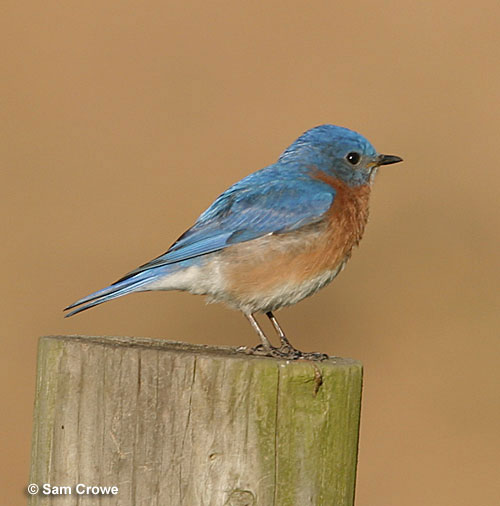
Scientific name: Sialia sialis
Length: 6.3 to 8.3 inches
Weight: 1.0 to 1.1 ounces
Wingspan: 9.8 to 12.6 inches
Song: “tu-a-wee”
Male Eastern Bluebirds are brick-red or rusty on their breast and throat and are a deep, vivid blue above. How blue these birds look fully depends on the lighting at the time. From a distance, males often look like a dull gray-brown. Female Eastern Bluebirds are a subdued orange-brown on the breast, grayish above, and have bluish wings and tails.
Eastern Bluebirds inhabit open country around trees. However, these locations have sparse ground cover and little understory. These birds primarily consume insects on the ground; some of the prey they consume include beetles, caterpillars, crickets, spiders, and grasshoppers.
Eastern Bluebirds are also known as the state birds of Missouri.
Key Identifications:
- These birds are deep blue above and brick-red or rusty on their breast and throat.
- When Bluebirds are perched, the tips of their wings reach the base of their tail.
- Eastern Bluebirds are the size of a large sparrow but have a more upright posture.
- They have short necks, rounded heads, and short, thin bills.
Eastern Bluebirds are common birds that can be found in all parts of North America. They’re usually year-round residents of the southern portions of the country. They’re commonly seen in nesting boxes and old woodpecker holes, up to 50 feet off the ground. You can attract these birds to your yard by offering a smaller birdhouse because they prefer to nest in snug, tight spaces.
Black-capped Chickadee
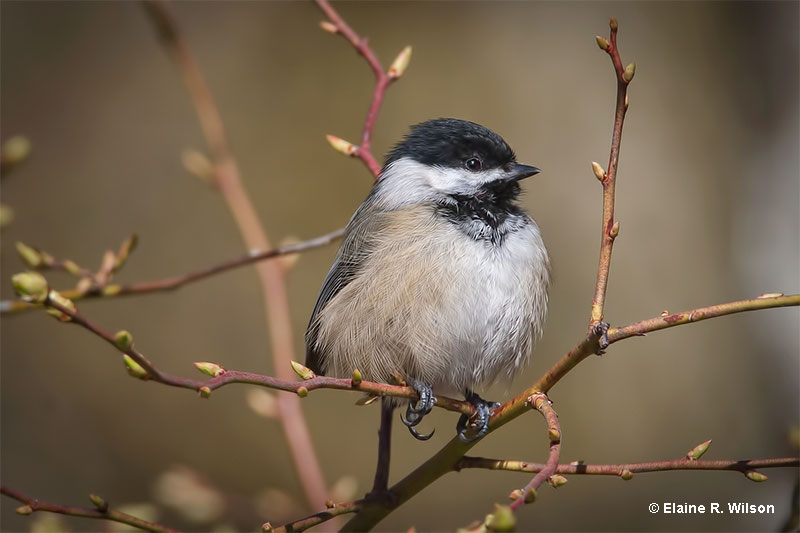
Scientific name: Poecile atricapilla
Length: 5.25 inches
Weight: .39 ounces
Wingspan: 8 inches
Song: “see bee, see bee”
Black-capped Chickadees are small grayish birds with a black cap, black throat, and a stubby black beak. Both sexes look alike and have a white face, white edging to the feathers in their wings, and some buff on their underparts.
These cute little birds feed on caterpillars, insects, spiders, seeds, and fruit. They are regular visitors to feeders but also forage on bark, twigs, and in foliage. When foraging, they often hang upside down from twigs and usually occur in small flocks.
This species makes a small, soft nest out of moss and deer hair. It builds its nest in tree cavities and can also use nest boxes.
Black-capped Chickadees live in a variety of wooded habitats and can also occur in gardens. They are year-round residents in parts of Alaska, Canada, and the northern USA south to Oregon, northern New Mexico, northern Ohio, and the Appalachian Mountains to North Carolina.
Key Identifications:
- Small, cute, grayish birds with a black cap, white face, and a black throat.
- Forages for insects, spiders, seeds, and fruit in wooded habitats. Also visits feeders.
- Nests in tree cavities and nest boxes.
- This little bird is quite vocal and often says its name, “chick-a-deedeedeedeedee”. They also make other chattering calls and sing a whistled song, “see bee, see bee”.
The Black-capped Chickadee is a small, acrobatic bird with a black cap, white face, and a black throat. It is also a state bird of Massachusetts. They usually forage in flocks with other chickadees and other small birds, and often visit feeders. This species hides dozens of seeds and other bits of food for the winter, and recalls where each of these food items are hidden.
Song Sparrow
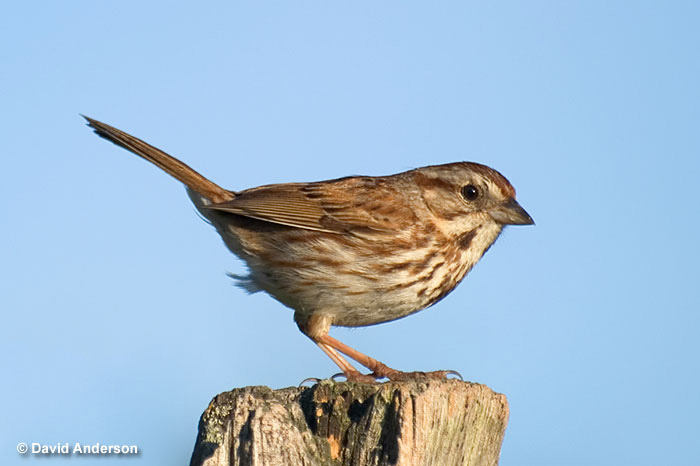
Scientific name: Melospiza melodia
Length: 4.7 to 6.7 inches
Weight: 0.4 to 1.9 ounces
Wingspan: 7.1 to 9.4 inches
Song: 2 to 6 phrases that usually start with well-spaced, abrupt notes and finishes with a trill or buzz.
Song Sparrows are streaky brown overall and have thick streaks on their flanks and white chest. When taking a closer look at these birds, we can see that their heads are an attractive mix of slaty gray and warm red-brown. It’s important to note that these shades, as well as the amount of streaking, can vary significantly across their range in North America.
Song Sparrows are found in a wide range of open habitats, including suburbs, tidal marshes, forest edges, arctic grasslands, lake edges, desert scrub, chaparral, and aspen parklands.
In the summer, Song Sparrows consume a lot of different insects and other invertebrates. Year-round they consume fruits and seeds. Some of the prey they consume include grasshoppers, weevils, caterpillars, craneflies, earthworms, and spiders.
Key Identifications:
- Song Sparrows are streaky brown overall and have thick streaks on their flanks and white chest.
- Their color and amount of streaking can vary significantly in Missouri and across their range in North America.
- These birds are slightly larger than a Chipping Sparrow.
- These sparrows are fairly bulky. They have short, stout bills, somewhat rounded heads, broad wings, and long, rounded tails.
Song Sparrows are one the most familiar sparrows in North America. However, there are 24 recognized subspecies of Song Sparrows. Northern and coastal birds are streakier and darker, while desert and southern birds have duller plumages. These birds regularly visit bird feeders as long as cracked corn, sunflower seeds, or safflower is offered.
Common Grackle
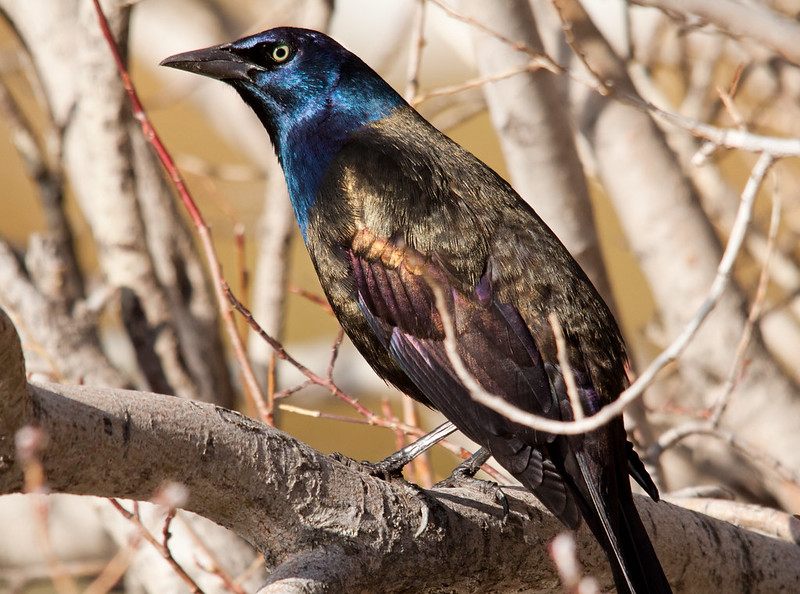
© Shawn McCready
Scientific name: Quiscalus quiscula
Length: 12.5 inches
Weight: 4 ounces
Wingspan: 17 inches
Song: “Sherink!”
The Common Grackle is a jay-sized, glossy black bird with pale eyes and a long, wedge-shaped tail. Depending on lighting, this bird shows metallic purple, blue, green, and bronze highlights.
Males and females look very similar but females have shorter tails and less iridescence. Both sexes also have stout, black beaks, and strong, black legs and feet.
In flight, Common Grackles move up and down as they move through the air. They usually flock together and often forage in farm fields, on lawns, and in other open habitats. These omnivores feed on a variety of items including insects, seeds, grain, small animals, garbage, and the eggs and nestlings of other birds.
Common Grackles build bulky stick nests, usually in conifers in woodlands, parks, near water, and urban areas.
This species can form big flocks in the winter and lives in a variety of semi-open and open habitats in eastern Canada and the eastern USA.
Key Identifications:
- Fairly large, black bird with glossy purple, greenish, bronze, or dark blue highlights. It also has pale eyes and a long, wedge-shaped tail.
- Forages for insects, seeds, and other food on the ground in a variety of open habitats.
- Constructs a bulky cup nest in a conifer.
- Common Grackles are vocal birds. They frequently give raspy, metallic calls, “Sherink!”, and “kek” calls.
The Common Grackle is a common, glossy black bird with pale eyes. It usually occurs in flocks in open and park-like habitats. This species occasionally nests in odd places, including occupied nests of Great Blue Herons and Ospreys!
Indigo Bunting
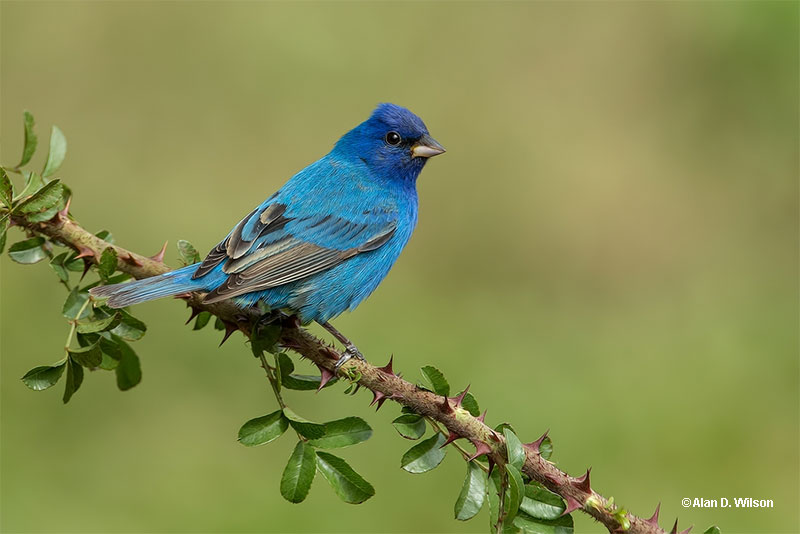
© Alan D. Wilson
Scientific name: Passerina cyanea
Length: 5.5 inches
Weight: .51 ounces
Wingspan: 8 inches
Song: “seet seet, sweet sweet, chip chup, swee sweet”
The Indigo Bunting is a small, finch-like bird with a grayish finch-like beak. Around the same size as a sparrow, males are deep, dark blue birds with some black on their face, wings, and tail.
Females are pale-brown birds with some white on their throat and belly, a hint of a buffy eyering, and two buff wing bars. They also have some faint streaks on their underparts and bits of blue on their rump, wings, and tail.
Indigo Buntings feed on insects, seeds, and some berries. They find food on the ground and also take seeds and berries while perched.
The Indigo Bunting uses grass and other bits of plant matter to make an open cup nest. They build their nests in shrubs and other low, dense vegetation.
This beautiful bird is a summer resident in forest edge and brushy habitats in southeastern Canada, the eastern and central USA, and in parts of the American Southwest.
Key Identifications:
- Sparrow-sized bird with a finch-like beak. Males are deep, dark blue. Females are mostly pale brown with faint streaks below and some buff highlights.
- Feeds on insects, seeds, and berries in brushy habitats.
- Makes an open cup nest with soft bark and other soft plant matter.
- Often makes a sharp call, “Pik!”. It also sings a halting song, “seet seet, sweet sweet, chip chup, swee sweet”.
This species forages for insects, seeds, and berries near and on the ground. Male Indigo Buntings appear blue because of the way microscopic structures in their blackish plumage refract and reflect blue light waves.
Red-tailed Hawk
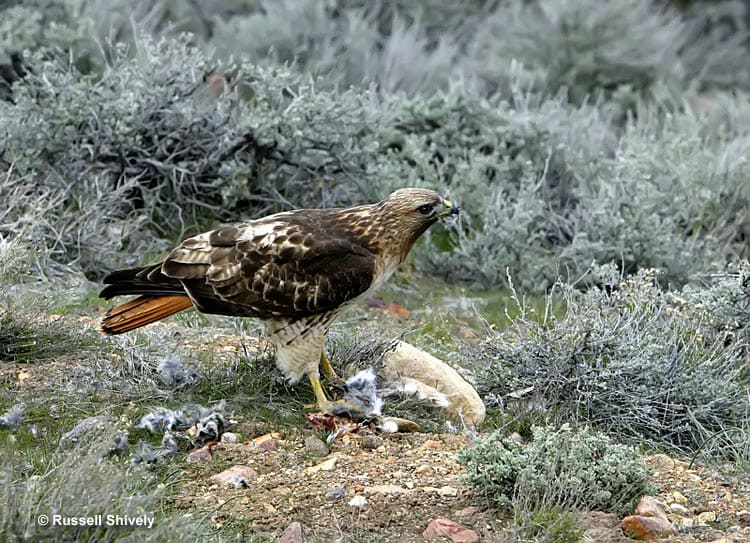
Scientific name: Buteo jamaicensis
Length: 19 inches
Weight: 2.4 pounds
Wingspan: 49 inches
Song: “Kreeeyahh!”
The Red-tailed Hawk is a large and chunky raptor with a broad, orange or reddish tail. Males and females look alike although females are larger.
These raptors are dark brown above and are pale below with dark markings on their belly. Young birds are more streaked on their underparts, and have brown tails with dark barring.
Red-tailed Hawks often soar and have long, broad wings that can show pale square patches on the bases of their primaries. While soaring, they watch for squirrels and other small animals that they feed on.
When they spot prey, these big birds drop down to catch it with their talons. This hawk also hunts by watching for prey from a perch.
Related: Most common hawks of Missouri
The Red-tailed Hawk builds a large, bulky, stick nest high in trees. They thrive in a wide variety of habitats but especially in woodlands near fields and other open habitats.
This raptor lives from Alaska and Canada south to Central America.
Key Identifications:
- Large, bulky hawk with a broad, reddish tail.
- Catches squirrels, rats, pigeons, and many other small animals on the ground.
- Nests in large, bulky nests made of sticks.
- A vocal raptor, Red-tailed Hawks often call in flight. They usually give a “classic” but quiet sounding raptor scream, “Kreeeyahh!”.
Red-tailed Hawks are large dark brown and pale hawks with broad, reddish tails. The most common raptor in many areas, they often perch on powerline poles along roads. The Red-tailed Hawk’s vision is eight times better than a person’s; they can spot a tiny rodent while soaring 100 feet above it.
Great Blue Heron
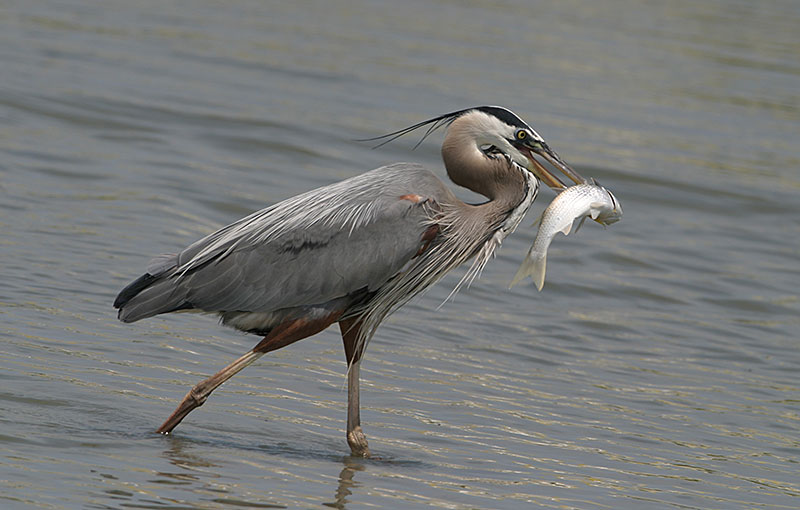
Scientific name: Ardea herodias
Length: 46 inches
Weight: 5.3 pounds
Wingspan: 72 inches
Song: “Grunk! Grunk!”
The Great Blue Heron is a large, gray and pale brown heron with a long neck and legs. It has a strong, yellowish beak, black and white head with a wispy black crest, and rufous thighs.
Both sexes are alike and have pale bellies and black flanks. Juveniles have streaked underparts.
In flight, they make slow, deep flaps with long, broad gray and black wings. In Southern Florida and the Caribbean, Great Blue Herons are all white and sometimes considered a separate species, the “Great White Heron”.
These powerful herons feed on fish and small animals such as rats, snakes, and birds. They wade in and near water, wait, and then quickly catch prey with their sharp beaks.
Great Blue Herons build messy, stick nests and breed in colonies, often in swamps.
We find these impressive birds in and near a wide variety of wetlands in large parts of Canada, the USA, and the Caribbean.
Key Identifications:
- Huge gray and pale brown wading bird with a thick, yellowish beak and a wispy crest. In southern Florida, it is all white but still has a crest and a strong yellowish beak.
- Stalks and preys on fish and small animals.
- Builds messy stick nests and breeds in colonies.
- Great Blue Herons aren’t all that vocal. When taking flight they make a croaking sound, “Grunk! Grunk!“.
The Great Blue Heron occurs on rivers, lakes, and many other wetlands. It stands still for long periods of time while waiting for prey to come within range of its sharp beak but is also, often seen in flight. These birds are known as, “Wurdemann’s Heron”.
Brown-headed Cowbird
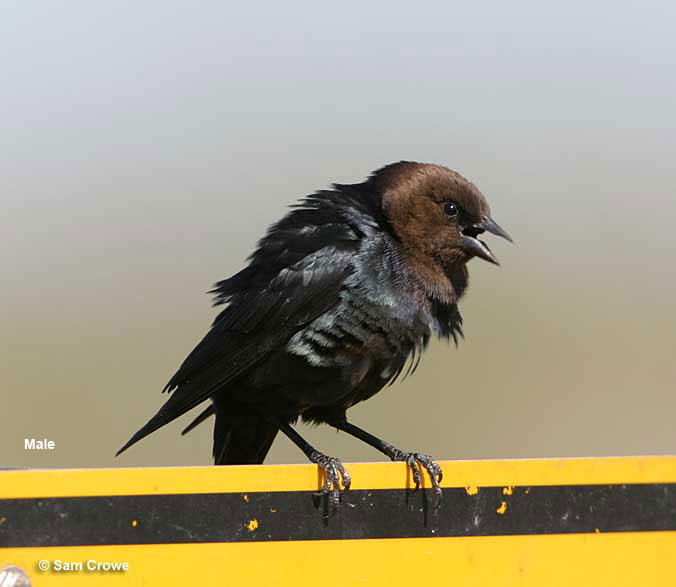
Scientific name: Momothrus ater
Length: 7.5 inches
Weight: 1.5 ounces
Wingspan: 12 inches
Song: “qwuipuh see!”
The Brown-headed Cowbird is a smallish blackbird with a short beak and fairly long wings. Males are glossy black with a dark brown head. Female Brown-headed Cowbirds are dark grayish birds with a dark beak, black eyes, and a white throat.
These small blackbirds forage for seeds and insects on the ground. They usually occur in flocks that forage on pastures and around farms. Cowbirds do most of their foraging with cows, horses, or other large animals to catch insects that the big mammals scare out of hiding.
Brown-headed Cowbirds do not build a nest. Instead, females lay eggs in nests of other birds. Host species can be Northern Cardinals, various warblers, vireos, and many other small birds.
The Brown-headed Cowbird is dependent on cattle, horses, and other large grazing mammals but occurs in a wide variety of habitats. It prefers fields, pasture and other open areas, and lives in southern and western Canada, the USA, and much of Mexico. They are one of the most common birds of Missouri.
Key Identifications:
- Smallish blackbird with a brown head (males) and rather short beak. Females are dark gray with a white throat.
- Flocks forage for seeds and insects on the ground.
- Lays eggs in nests of other birds.
- This species is fairly vocal and often makes a rattling call. Males sing a brief song with bubbly and high-pitched notes, “qwuipuh see!”.
The Brown-headed Cowbird is a smallish blackbird with a short beak and brown head (male), or is gray with a white throat (female). This species flocks together and is very common in pastures and farming areas. Brown-headed Cowbirds have laid their eggs in nests of more than 220 species.
Mallard
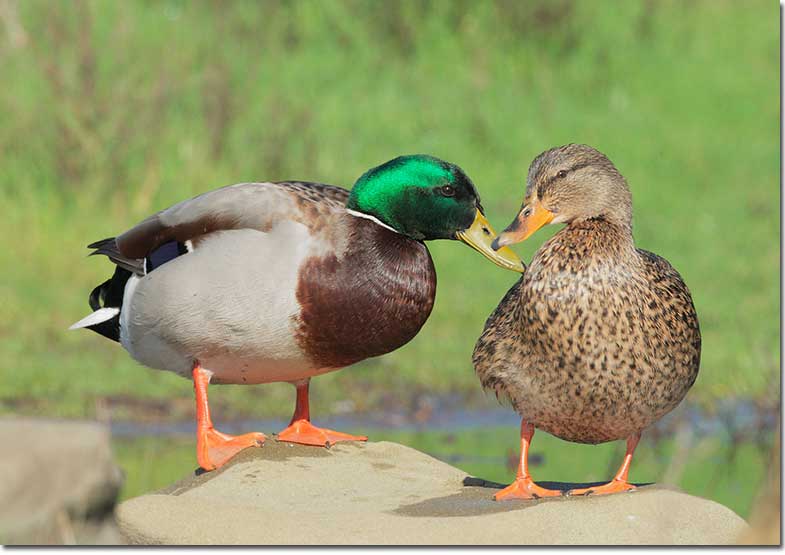
Mallard pair (Male and female)
Scientific name: Anas platyrhynchos
Length: 23 inches
Weight: 2.4 pounds
Wingspan: 35 inches
Song: “quack, quack”
The Mallard is a fairly large, familiar duck. The male has a metallic green head, yellow bill, narrow white ring around the neck, and chestnut breast. The rest of the bird is pale gray with pale brown, and black on its back and around his tail.
Female Mallards are mottled brown and buff with a dark crown and line through the eyes, and have a dark gray and orange beak.
In flight, both sexes show a green-blue wing patch bordered with white.
Mallards eat a variety of items, including insect larvae, snails, other small aquatic creatures, acorns, seeds, and grain. They forage by filtering and picking up food items in and near shallow water, and in farm fields.
This duck species makes a shallow nest with sticks and lined with down feathers. They live in rivers, ponds, marshes, and many wetland habitats in Canada, USA, and Eurasia.
Key Identifications:
- Large and familiar duck, male has dark green head, white ring around the neck, and a chestnut breast. Female is mottled buff and brown, and has a dark gray and orange beak.
- Feeds on insect larvae, grain, seeds, and other items picked up with its bill in and near shallow water.
- Makes a shallow stick nest hidden in grass or under a bush.
- The female Mallard makes the classic “quack, quack” duck sound. Males make similar but softer sounds and a whistling call.
Mallards often live near people and occur on lakes, ponds, and other wetlands. No matter how different they look, most small domestic duck species are descended from wild Mallards.
Ruby-throated Hummingbird
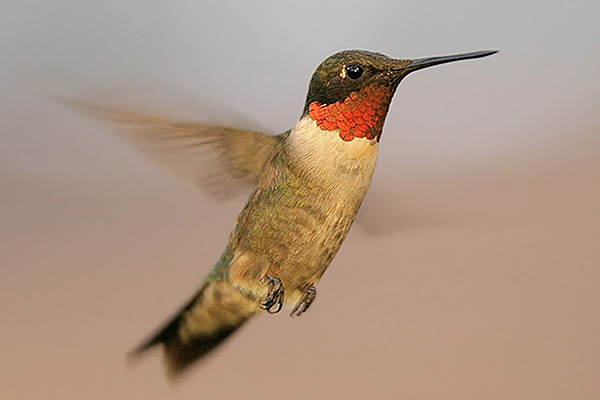
Photograph © Greg Lavaty.
Scientific name: Archilochus colubris
Length: 3.75 inches
Weight: .11 ounces
Wingspan: 4.5 inches
Song: “tik,chickechikchicktiktik”
Ruby-throated Hummingbirds are tiny birds with long, sharp, needle-like beaks. Males are green above and grayish-green below with a broad white semi-collar on their breast and neck. They also have a dark, forked tail, and a glittering orange-red throat.
Females have a pale throat, a small white spot behind each eye, and black and white on the tip of their tail.
This hummingbird species feeds on nectar and tiny insects. It takes nectar from a variety of small flowers and visits hummingbird feeders. They also catch small insects in flight.
Ruby-throated Hummingbirds make small cup nests out of lichen, spider webs, and plant matter. The female constructs the nest on a branch of a tree, often high up.
Ruby-throated Hummingbirds breed in woodland habitats in central and southeastern Canada, and the eastern USA. We often see them in gardens and at hummingbird feeders, especially during migration.
They migrate to Mexico and Central America for the winter.
Key Identifications:
- Tiny greenish bird with a long, straight beak. Males have glittering red throats and females have pale throats and a small white spot behind the eye.
- Takes nectar from flowers, visits hummingbird feeders, and eats tiny insects.
- Makes a small cup nest of lichen, spider webs, and plant matter in a tree.
- The Ruby-throated Hummingbird makes lots of chipping and sputtering calls. They often sound like, “tik,chickechikchicktiktik”.
The Ruby-throated Hummingbird is a tiny bird and the only hummingbird species that breeds east of the Rocky Mountains. They live in wooded habitats and often visit gardens. During migration, many individuals of this migrant species fly hundreds of miles across the waters of the Gulf of Mexico.
Killdeer
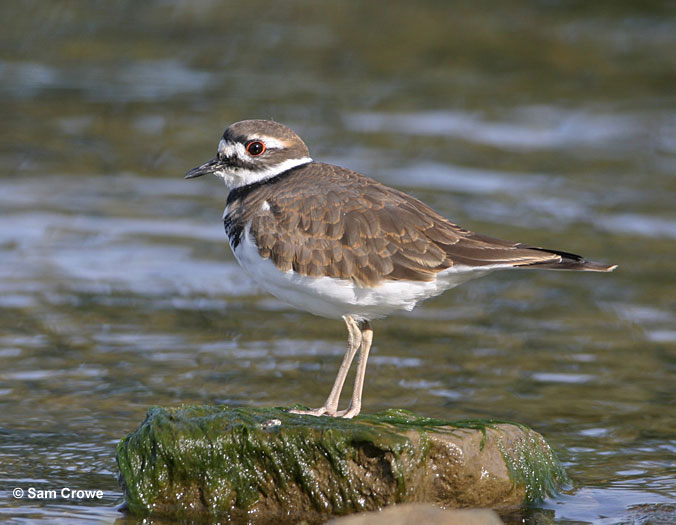
Scientific name: Charadrius vociferus
Length: 10.5 inches
Weight: 3.3 ounces
Wingspan: 24 inches
Song: “tideer, tideer, tideer, tideer”
The Killdeer is a fair-sized, slender plover that is dark brown above and white below. They have two black bands on their breast, a patterned, black, white, and dark brown face, and a longish, orange tail.
Both sexes look alike and also have a slender, black bill, narrow, red-orange eyerings, and long, pale legs. In flight, we can see a white stripe in each of their long, dark wings, and a black tip on their long, wedge-shaped, orange tail.
Killdeers often fly high overhead in fast, direct flight but we usually see them foraging on the ground. They pick insects, other small creatures, and seeds from the edges of wetlands and other, open grassy areas.
This species lays its camouflaged eggs on the ground, in gravel and open fields. When people and pets approach too close, they give loud calls and pretend to have a broken wing.
The Killdeer lives in large parts of Canada, the USA, Mexico and also Missouri.
Key Identifications:
- Fair-sized plover with two black breast bands and a wedge-shaped orange tail with a black tip.
- Picks seeds and small creatures from open ground.
- Lays camouflaged eggs on the ground, in gravel and open fields.
- Very vocal and sounds like it says its name, “tideer, tideer, tideer, tideer”.
The Killdeer is the most common and familiar shorebird in much of its range and occurs in many open habitats. It is the only plover in North America with two black breast bands and has a longish, orange tail with a black tip. To scare cows near their nests, Killdeers fluff themselves to look bigger, raise their tail over their head, and run at the large animal.
Eastern Wood-Pewee
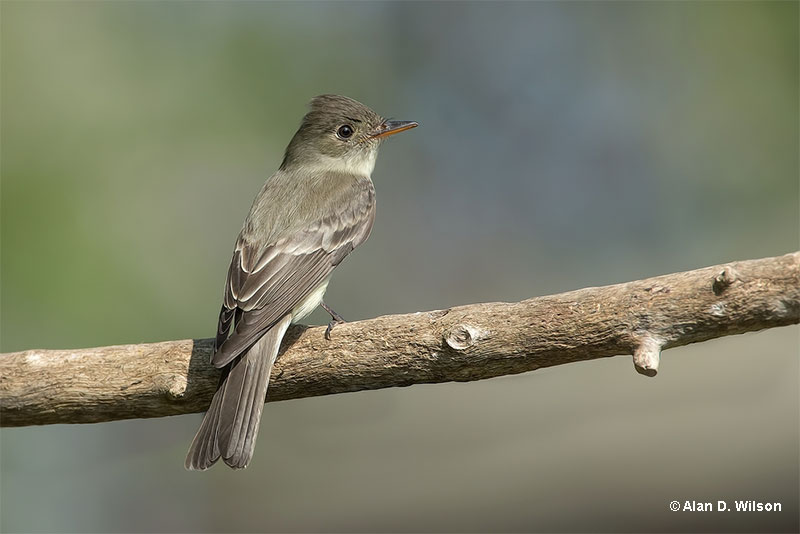
© Alan D. Wilson
Scientific name: Contopus virens
Length: 6.25 inches
Weight: .49 ounces
Wingspan: 10 inches
Song: “pee-oh-wee!”
The Eastern Wood-Pewee is a small, plain grayish-brown flycatcher with two pale wing bars, a hint of a crest, and a partial, faint eyering. Both sexes look alike and also have some white edging to the feathers in their long wings, and grayish on their breast and flanks.
The rest of their underparts can be dingy white or pale yellow, and they have some orange on their straight beaks.
Eastern Wood-Pewees feed on a wide variety of insects. They forage by waiting on a perch (often high overhead), and then flying out to catch insect prey in flight. After snatching the bug with their beak, they return to the same perch to eat it.
This species makes a small cup nest from grasses, twigs, hair, and lichen. Their nest is well camouflaged and looks just like a knot on the branch it is built on.
Eastern Wood-Pewees are summer residents in woodlands of southeastern Canada and the eastern USA.
Key Identifications:
- Small, grayish-brown, plain flycatcher with a small crest, faint eyering, and two pale wing bars.
- Flies from a high perch to catch insects in flight.
- Makes a small cup nest out of plant matter and camouflages it with lichen.
- Often says its name with a whistled song, “pee-oh-wee!”.
The Eastern Wood-Pewee is a plain, grayish-brown flycatcher with a faint eyering and two wing bars on long wings. This bird does not join flocks and sallies from a high perch to catch insects in flight in woodland habitats. Many of these familiar summer birds spend the winter in wild and remote areas of the western Amazon rainforest.
Red-shouldered Hawk
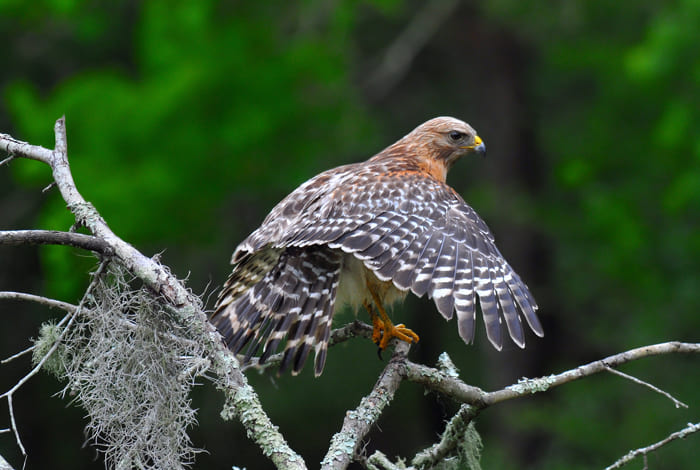
Scientific name: Buteo lineatus
Length: 17 inches
Weight: 1.4 pounds
Wingspan: 40 inches
Song: “Kyeah, Kyeah, Kyeah, Kyeah!”
The Red-shouldered Hawk is a medium-sized raptor with a black and white tail. This crow-sized hawk is dark brown and reddish above and has reddish-orange underparts.
Males and females look alike but females are larger. This hawk also has a dark mark on each side of its throat, and black and white wings with a red shoulder. Juveniles resemble adults but are brown with dark brown streaks below.
In flight, Red-shouldered Hawks have long, broad wings with a pale, crescent-shaped mark on the base of their primaries.
These raptors feed on small animals including frogs, snakes, squirrels, and occasional birds. They hunt by watching from a perch and them swooping down to catch the animal on the ground.
Red-shouldered Hawks build a bulky stick nest high in a tree and live in hardwood forest habitats. We find them in southeastern Canada, the eastern USA, and from southern coastal Oregon south to Baja California.
Key Identifications:
- Crow-sized, colorful raptor with reddish-orange below and black and white wings and tail.
- Preys on snakes, frogs, and other small animals.
- Builds a bulky nest high in a tree.
- Red-shouldered Hawks are vocal raptors that make loud, jay-like, or even gull-like calls. They often make a repeated sound, “Kyeah, Kyeah, Kyeah, Kyeah!“, and can also make shorter “Kiyip! Kiyip!” calls.
The Red-shouldered Hawk lives in hardwood forest and other woodlands. In some areas, it is an urban bird and one of the most common raptors. Red-shouldered Hawks can join American Crows to chase Great-Horned Owls away from their territories.
Barn Swallow
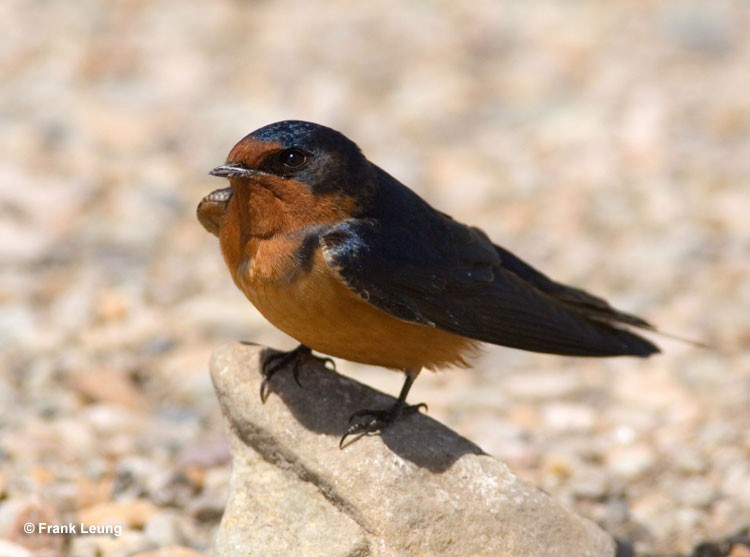
Scientific name: Hirundo rustica
Length: 6.75 inches
Weight: .67 ounces
Wingspan: 15 inches
Song: “chipchipfitfibitchipfibitfwip”
Barn Swallows are small to medium-sized swallows with long forked tails. They are dark, steel-blue above, peach-orange below, and have rich chestnut on the throat and above their bill. It also has some white in its tail.
Males and females look similar, but females are paler and have shorter tails. Young birds are like females but their tails are even shorter.
The Barn Swallow is one of the most common birds in Missouri. It has long, pointed wings and fast flight. When flying, they often flap their wings a few times between brief glides.
Barn Swallows live in farming areas, meadows, parks, and other open habitats. They feed on insects as they fly through the air. Although they can fly high overhead, Barn Swallows often swoop low over the ground.
This handsome swallow builds a mud nest on the wall of a barn, bridge, or other structure. Barn Swallows live in large areas of Canada, the USA, Mexico, Europe, and Asia.
Key Identifications:
- Beautiful dark blue and orange swallow with a long, forked tail.
- Forages for insects in flight over fields and other open habitats.
- Constructs a cup nest out of mud in barns and other structures.
- Often makes brief “fwip” calls in flight, and has a long, complex song, “chipchipfitfibitchipfibitfwip”.
The Barn Swallow is a common and easily species in most of its range, and the only swallow with a long, elegant tail. In summer, it is often seen flying low over the ground in open habitats. Barn Swallows are long-distance migrants, and some fly 5,000 miles, all the way to Argentina!
Frequently Asked Questions
How many bird species are native to Missouri?
In total, 439 bird species are native to Missouri. There are 439 species of birds on the Missouri list.
What is the most common bird in Missouri?
The most common bird in Missouri is the Northern Cardinal. According to eBird data, this species has been seen more often than any other bird in the state.
What is the largest bird in Missouri?
The largest bird in Missouri is the American White Pelican. This huge bird has a nine foot wingspan and a length of 62 inches. Another big bird in Missouri is the Trumpeter Swan. It is 60 inches in length, weighs 23 pounds, and has a wingspan of 80 inches. The tallest bird is a species with a height of five feet; the Whooping Crane.
What is the smallest bird in Missouri?
The smallest bird in Missouri is the tiny Calliope Hummingbird. This rare migrant to Missouri is just 3.25 inches long.
What is the fastest bird in Missouri?
The fastest bird in Missouri is the Peregrine Falcon. This impressive falcon is the fastest bird in the world. It reaches speeds of 200 miles per hour!
Read next: Woodpeckers in Missouri | Hawks in Missouri | Owls in Missouri


